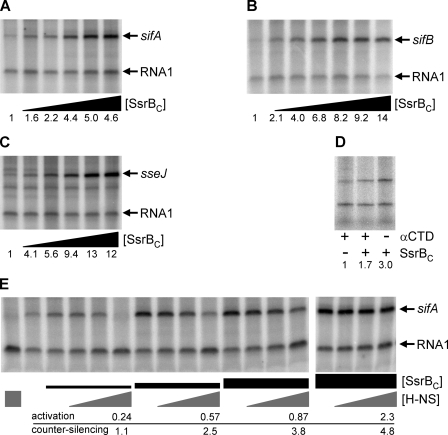FIGURE 3.
SsrBC directly activates transcription of sifA, sifB, and sseJ and overcomes silencing by H-NS. A–C and E, in vitro transcription with supercoiled template was used to test the ability of SsrBC to directly activate transcription of sifA (A), sifB (B), and sseJ (C). The 110-nt RNA-1 internal control transcripts are indicated. Subsequent lanes of each panel contain, from left to right, 0, 12.5, 25, 50, 100, and 200 nm SsrBC for sifA and sseJ; the concentration range employed for sifB is 0, 6.25, 12.5, 25, 50, 100, and 200 nm. The gene-specific transcripts are indicated by arrows. D, αCTD of RNAP is not required for SsrBC activation of sifA. In vitro transcription was performed with 20 nm His6-β′ RNAP or a derivative containing a truncation of αCTD. Each lane contains 20 nm RNAP with (+) or without (−) αCTD. The presence (+) of absence (−) of 50 nm SsrBC is also indicated. A–D, the fold induction (0 nm SsrBC = 1) is indicated below. E, SsrBC was added to sifA transcription template pre-bound with H-NS to examine counter-silencing of transcription. The left-most lane contains 200 nm H-NS, and the 2nd lane from the left contains only RNAP. The SsrBC concentrations employed (indicated by black boxes) were 25, 50, 100, and 200 nm. The relative H-NS concentrations (50, 100, or 200 nm) are indicated by gray triangles. The activation (0 nm SsrBC = 1) and counter-silencing (200 nm H-NS = 1) ratios as described in the text are indicated for each reaction containing 200 nm H-NS and the indicated concentration of SsrBC.

